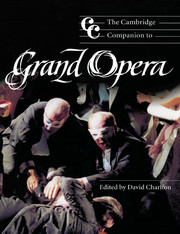Book contents
- Frontmatter
- 1 Introduction
- Part I The resourcing of grand opera
- Part II Revaluation and the twenty-first century
- Part III Grand operas for Paris
- 9 La Muette and her context
- 10 Scribe and Auber: constructing grand opera
- 11 Meyerbeer: Robert Ie Diable and Les Huguenots
- 12 Meyerbeer: Le Prophète and L'Africaine
- 13 The grand operas of Fromental Halévy
- 14 From Rossini to Verdi
- 15 After 1850 at the Paris Opéra: institution and repertory
- Part IV Transformations of grand opera
- Notes
- Select bibliography
- Index
11 - Meyerbeer: Robert Ie Diable and Les Huguenots
from Part III - Grand operas for Paris
Published online by Cambridge University Press: 28 November 2011
- Frontmatter
- 1 Introduction
- Part I The resourcing of grand opera
- Part II Revaluation and the twenty-first century
- Part III Grand operas for Paris
- 9 La Muette and her context
- 10 Scribe and Auber: constructing grand opera
- 11 Meyerbeer: Robert Ie Diable and Les Huguenots
- 12 Meyerbeer: Le Prophète and L'Africaine
- 13 The grand operas of Fromental Halévy
- 14 From Rossini to Verdi
- 15 After 1850 at the Paris Opéra: institution and repertory
- Part IV Transformations of grand opera
- Notes
- Select bibliography
- Index
Summary
Robert le Diable
The origins of Robert le Diable
Meyerbeer came to be considered one of the foremost composers in Italy towards the end of the 1820s, especially after the international triumph of his Italian opera Il crociato in Egitto (Venice, 1824; Théâtre Italien, Paris, 1825). Goethe, for instance, did not think anyone but Meyerbeer could set his Faust to music: ‘Mozart should have composed Faust. Meyerbeer would perhaps be capable; but he would not touch anything of the kind; he is too much engaged with the Italian theatres.’ Not surprisingly, Meyerbeer attracted the interest of the French too; since Piccinni's time down to the era of Spontini and Rossini they had always been able to attract the leading Italian operatic composers. Though initial contacts with Meyerbeer had been made by the director of the Paris Opéra in 1823, it was Guilbert de Pixérécourt, at that time director of the Théâtre Royal de l'Opéra Comique, who in 1826 offered him a commission for a three-act opéra comique. Because Pixérécourt relinquished his post the year after, nothing came of the plan. But this marked the start of intense collaboration between Meyerbeer and Eugéne Scribe, who was to remain the composer's chief librettist for the remainder of his life.
The original libretto of what was to become the nineteenth century's most frequently performed and highly rated opera, given at the most far-flung theatres, was the fruit of collaboration between Eugène Scribe and Germain Delavigne, who was responsible for the first sketches. He borrowed the title Robert Ie Diable from a Breton legend well known since the eighteenth century thanks to its inclusion in 'la Bibliotheque bleue' (cheap blue-covered books sold by hawkers) and through a host of subsequent melodrame and vaudeville adaptations.
- Type
- Chapter
- Information
- The Cambridge Companion to Grand Opera , pp. 189 - 207Publisher: Cambridge University PressPrint publication year: 2003
- 3
- Cited by



